My favorite Jimmy Buffett song, “Changes in Latitudes” has a verse, “Reading departure signs in some big airport reminds me of the places I’ve been.” Only the opposite is true for me. Reading departure signs in some big airport has always reminded me of places I still would like to go… and perhaps none so much as Addis Ababa. Through years of travel through international airports, I have always stood in awe of this quirky sounding city appearing on departure signs, and hoped that one day I would get to visit such an exotic-sounding place.
Our Dragoman tour would end in Addis Ababa, where I would say goodbye to Louise, our tour guide extraordinaire, and James, our driver, along with my eleven new friends and travel companions. A sense of dread came over me on that last drive from Bahir Dar to Addis Ababa, realizing that after 30 days, I was about to leave the safety and security of “Amelia,” our big orange cocoon of a truck. For 30 days, I had enjoyed a comfortable seat, safe place to secure my luggage, an ample supply of hand sanitizer mounted at the top of the steps. An on-board fridge kept my cold beers and Coke Zero cold, while large windows allowed the scenic views in while keeping the dirt and din out. Getting in and out of the truck had become my daily routine that I would sorely miss, particularly now landing in what felt like the scariest city I have visited in my life!
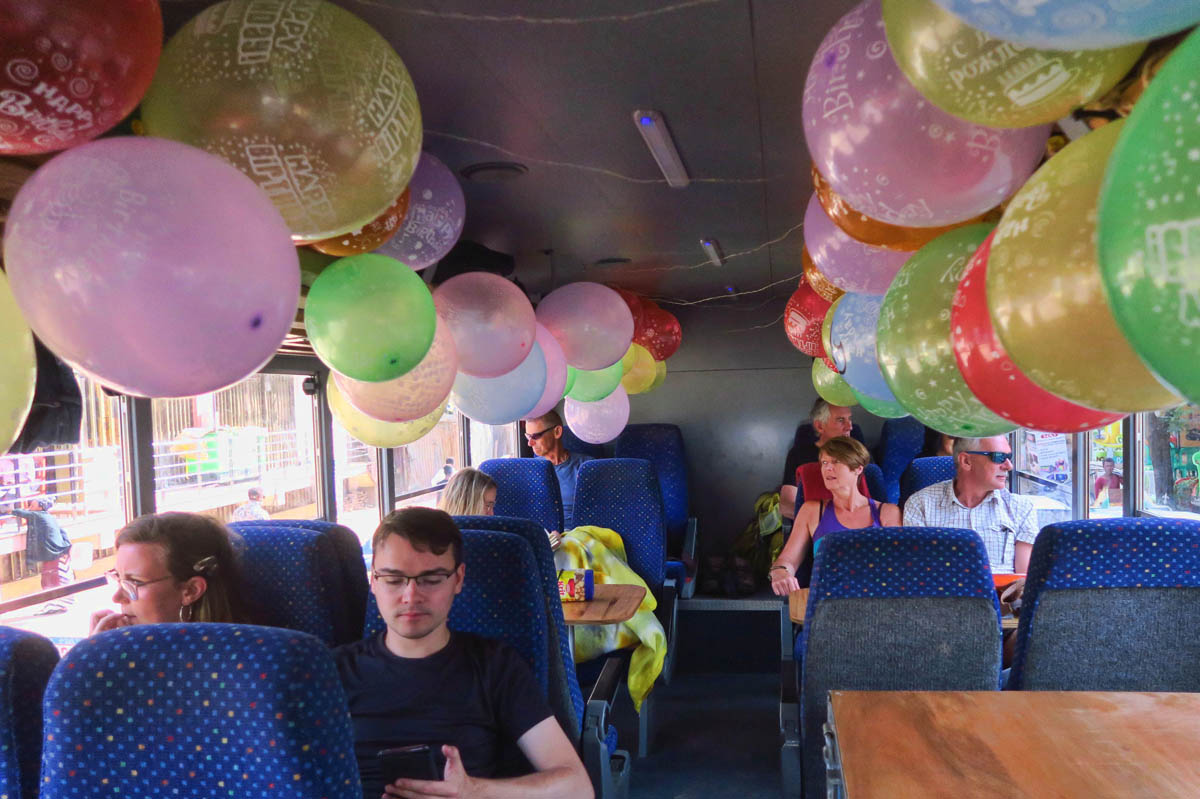
The last leg of our tour falls on Andy’s birthday, so we have a “truck party” the night before to decorate the truck to surprise him.
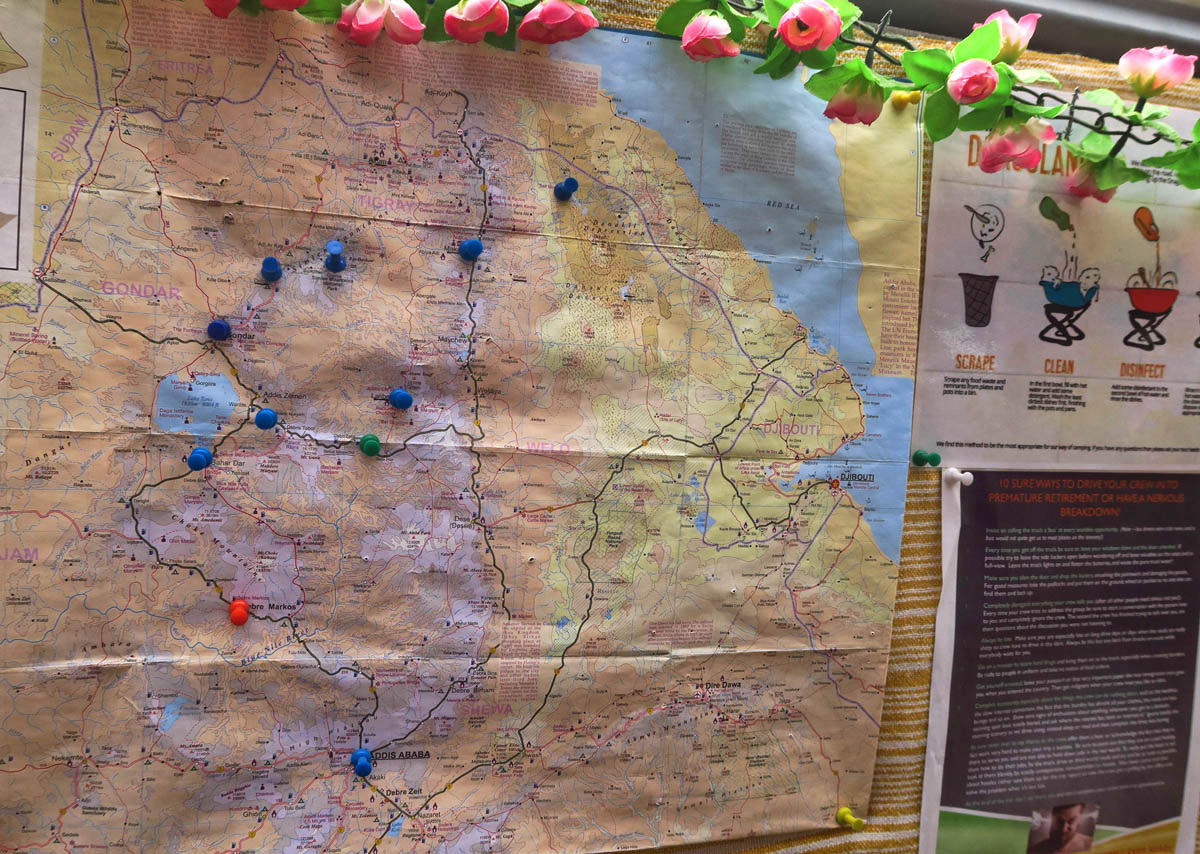
On this Information Board dividing the cab from the coach is a map where we have plotted our course around Ethiopia. The red pin serves as the “You Are Here.”
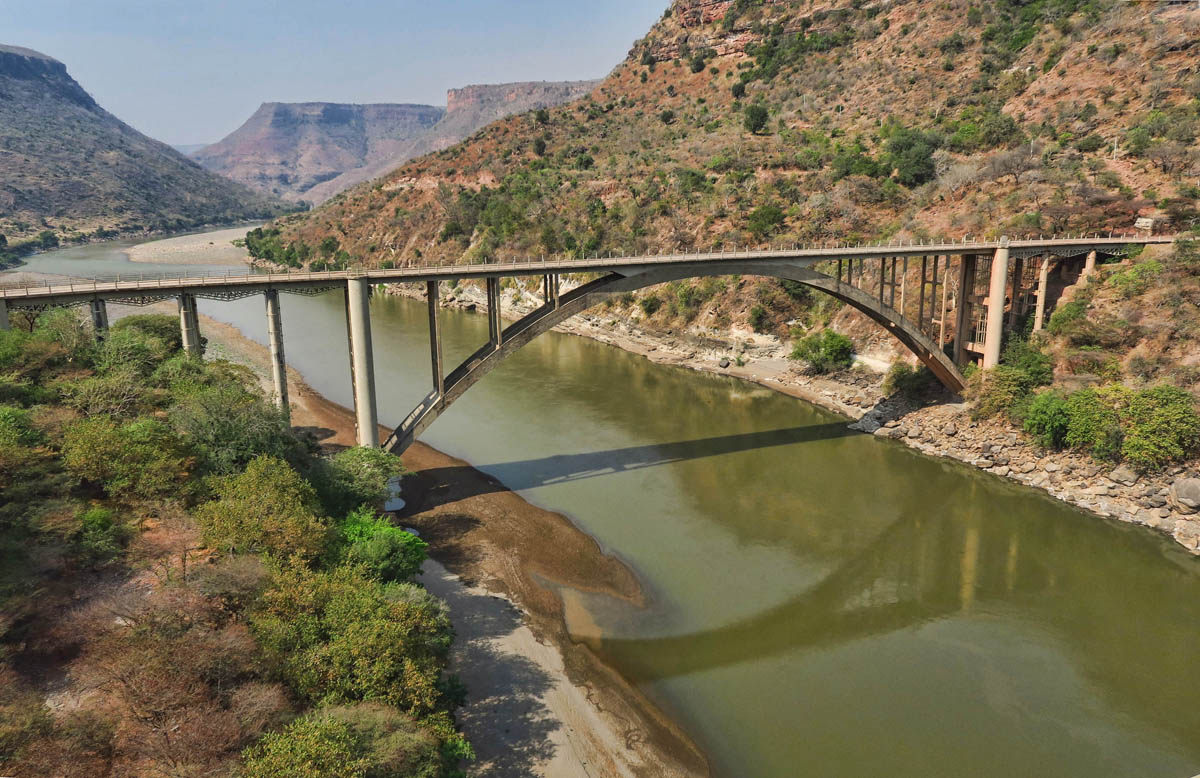
On our last day, we drive through the scenic Blue Nile Gorge.
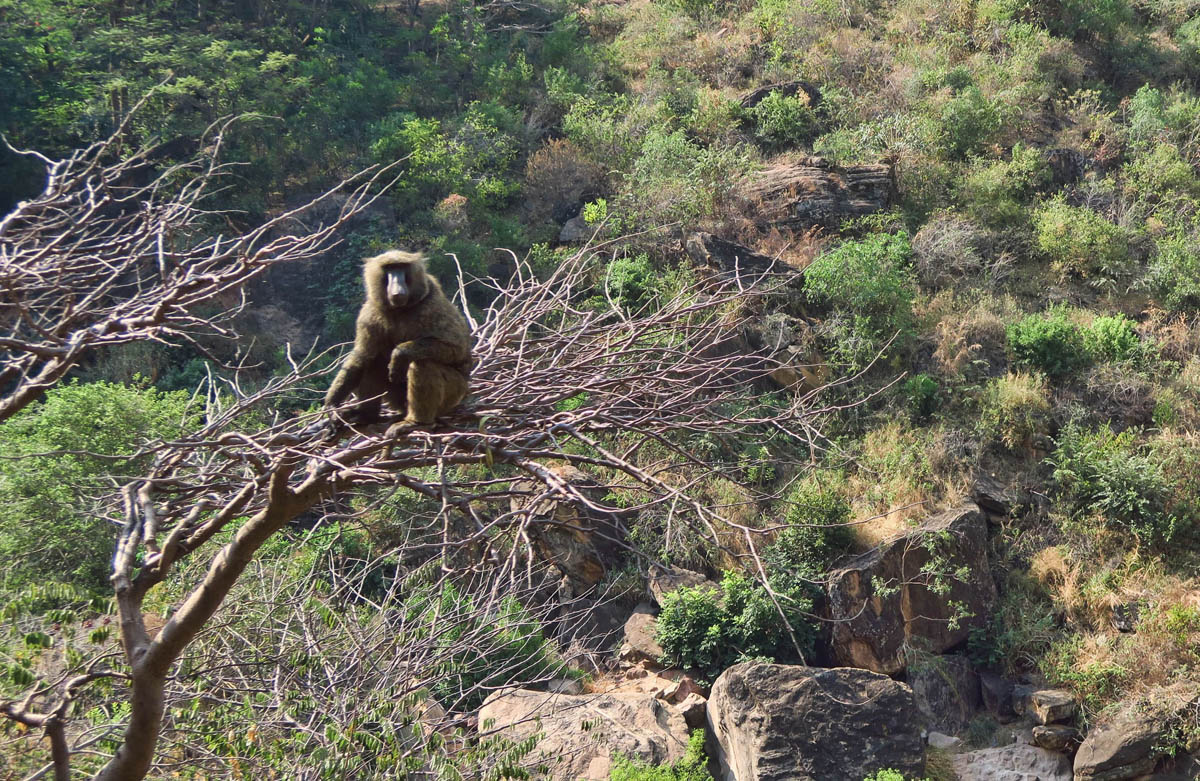
Not sure what kind of monkey this is, but they all seemed to enjoy looking at us people inside the rolling zoo!
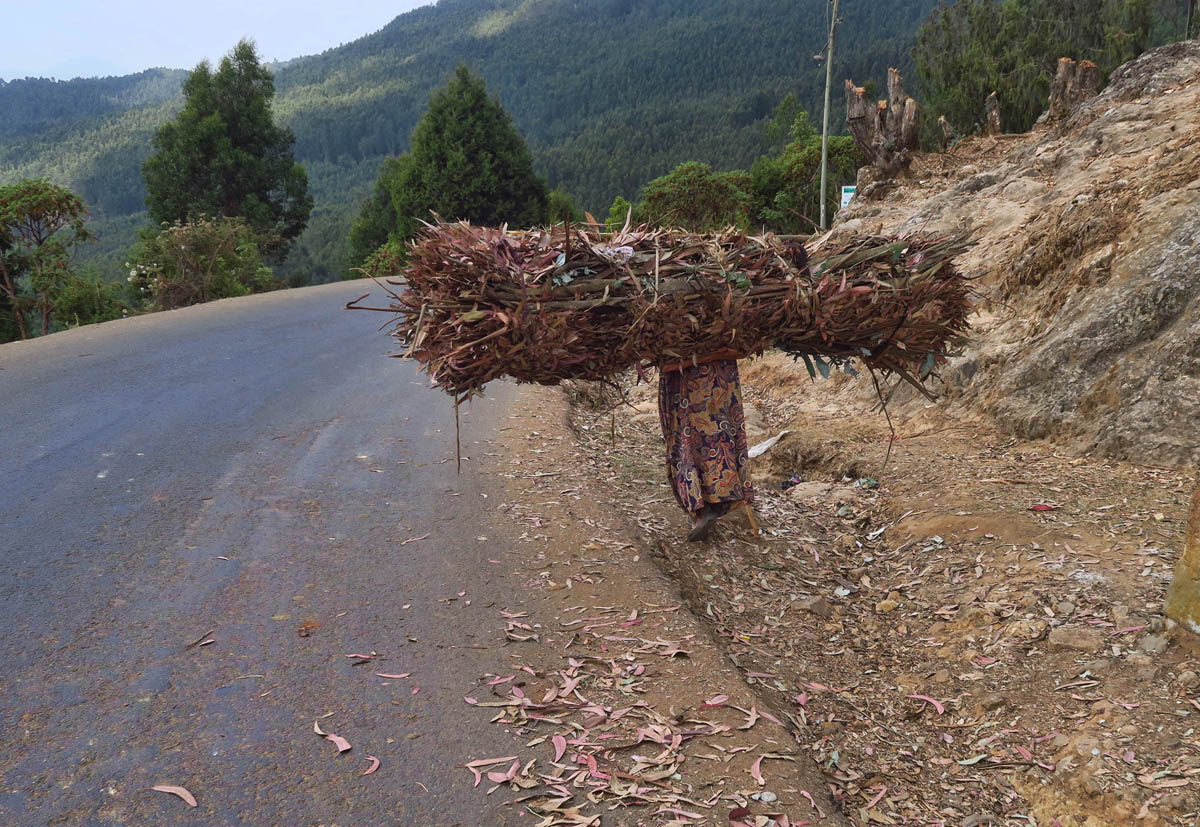
Women seem to bear the burden of heavy lifting in Ethiopia, this one carrying eucalyptus branches down from Mount Entoto to be used as firewood for cooking.
I first got a sense of what was in store for me in Addis Ababa when I watched a youtube video by a young Brit who had been gifted a free tour in exchange for making a marketing video for the tour company. When he spent 25% of what was to be a promotional video talking about ways to avoid petty theft, I got a knot in my stomach as he stated while violent crime is unlikely, pick-pocketing schemes are so rampant that it’s not a matter of “if” but “when.” I began to get apprehensive, particularly after my recent experience in Ecuador where not only my pocket was picked, but so was my entire hotel room. (Guess I still haven’t “moved on.”)
Situated at an elevation of 7,796 ft, rising up to 9,800 ft in the Entoto Mountains to the north, Addis Ababa is Africa’s highest capital city, fourth highest in the world. I had allotted myself a week to explore the city. I knew that was likely too long, but flight availability dictated that I either stay a little too long or leave a little too soon. Since the temperatures were in the low 70’s, I decided it was preferable to stay awhile to rest up in a place with such cool, dry mountain air before I headed into the sweaty armpit of India.
While I had accounted for the weather, I hadn’t accounted for the “atmosphere.” On my first walk out in broad daylight, I was greeted first by the hotel manager telling me that strapping my small cross-body bag across my shoulder wasn’t enough. I needed to also firmly grip it with my hand. As I rounded the corner out of my hotel on the way to the grocery store, I encountered a man standing on the sidewalk stark naked, without a stitch other than his pants crumbled down around his ankles. It was going to be a long week.

Yet another religious celebration taking place at the Church of St George in Addis.

Velvet beaded umbrellas and large wax wicks are ubiquitous in the Ethiopian Orthodox Christian ceremonies.
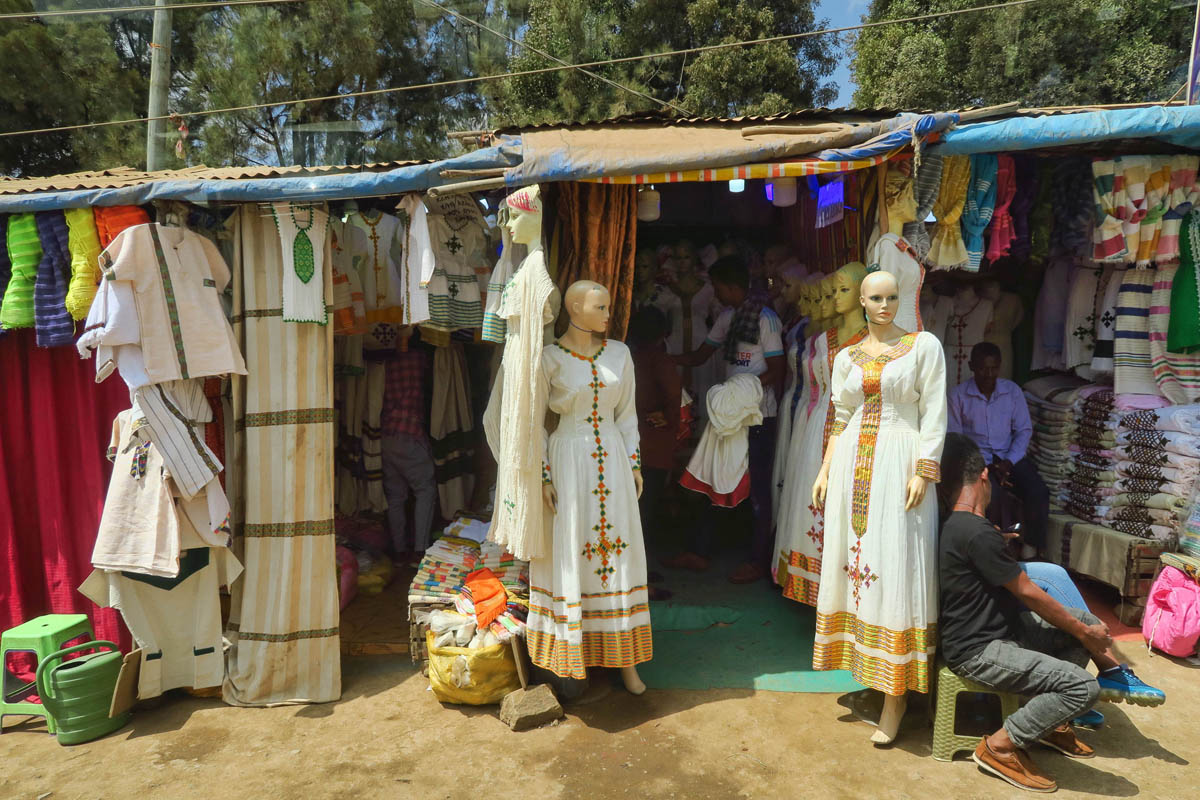
Traditional Ethiopian dresses for sale.
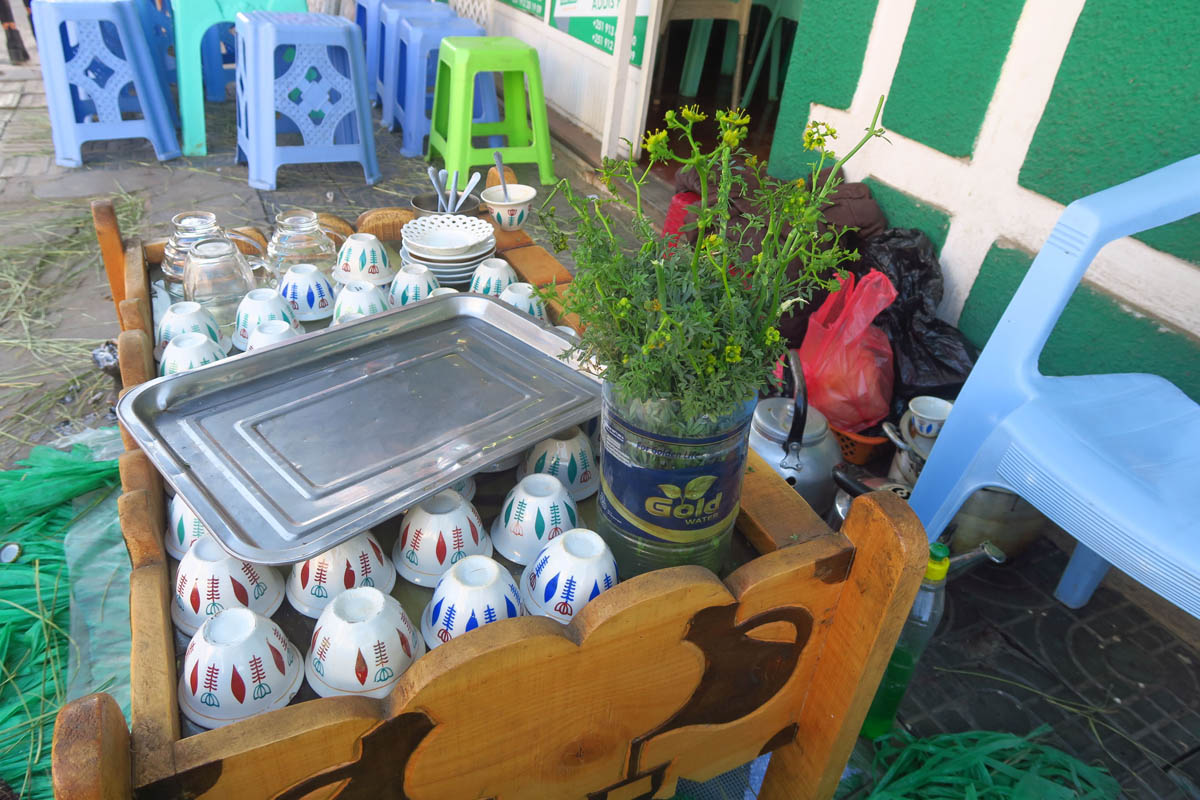
Another common sight on every street corner is the small, make-shift coffee shop with tiny plastic cups and tiny plastic stools to match.

I finally get to try ” tena adam,” this fern-like herb that is added to Ethiopian coffee. It really does remove the bitterness from the strong black coffee.

Looks like these haven’t been moved in a while. Guess there is no “Lovely Rita, Meter Maid” in Addis.

Medhane Alem Cathedral. The stark contrast between these religious monstrosities and the mud huts people live in stuns me over and over.
I had a list of places I wanted to explore while in Addis, one being the Merkato, largest outdoor market in Africa. Unfortunately, all the warnings of petty theft and pickpocket schemes didn’t make me feel comfortable exploring on my own, despite the fact that I had chosen a hotel within walking distance of the main tourist attractions.
I don’t typically like doing city tours, preferring instead to explore at my own pace with guidebook in hand. However, in this case, I decided it was the only way I was going to feel comfortable without constantly trying to look over both shoulders. I didn’t have enough hands to hold the guidebook while clutching all my valuables too! So I booked a tour with Addis Ethiopia Tours based on recommendations in Trip Advisor. Turns out, I was the only person on the tour, so it was like having a private guide and driver all to myself for the day.

I didn’t want to leave Ethiopia without visiting Addis’ Merkato, the largest outdoor market in Africa.
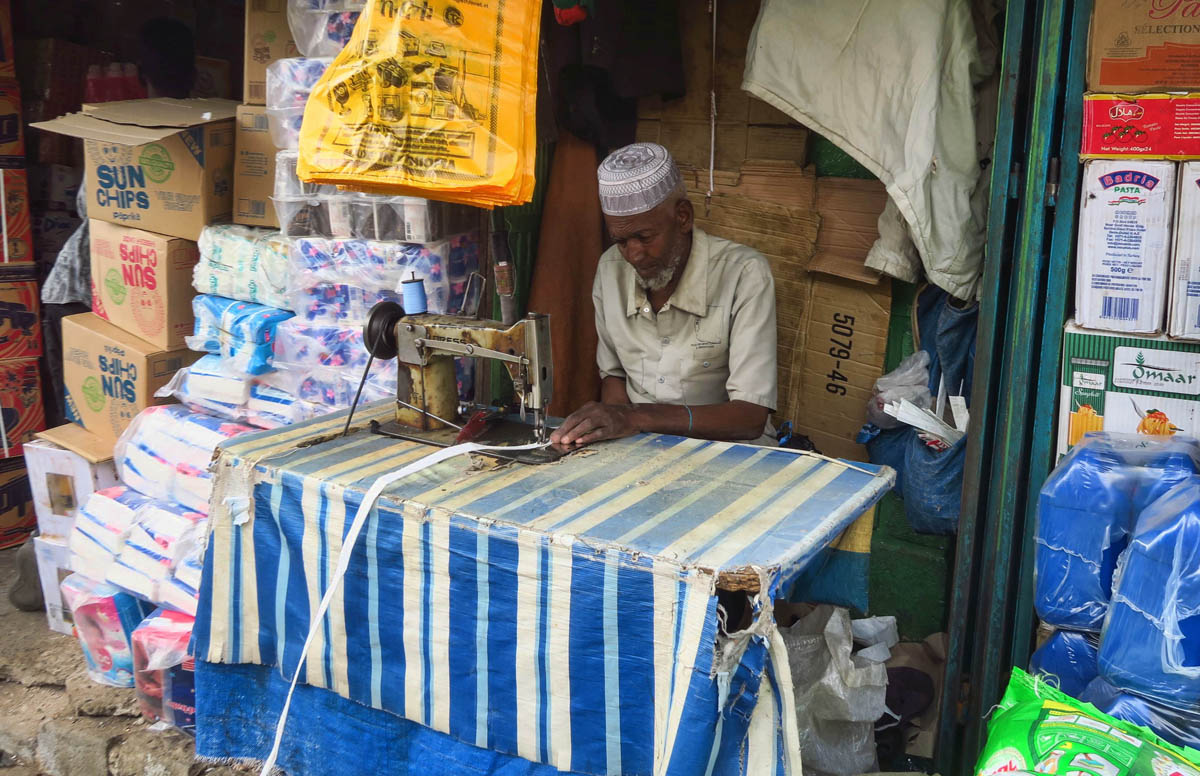
Merkato is said to cover several square miles with over 7,000 business entities that employ 13,000 people.

These women are selling a type of hops used in making the local libation, Tej, a mead or honey wine.

The Merkato is well sectioned off into specialty areas selling spices, grains, etc.

Most of the businesses are agriculture-related.

Local farmers bring their produce in to sell.

There is even a “chicken market.”

But nothing is so prevalent as Ethiopian coffee. Bags and bags, stand after stand, all selling coffee.
Also on my list of many things to see while in Addis was “Lucy,” the 3.2 million year old skeleton of what is considered to be an upright-walking primate and human ancestor fossil. Lucy, found in the Afar Region, northwestern Ethiopia in 1974, is considered to be the oldest known hominin. She was named for the Beatles’ song “Lucy in the Sky with Diamonds” that was playing in the paleoanthropologist’s expedition camp at the time her fossilized remains were discovered. After a world tour of several noteworthy museums, she is now at rest in Addis Ababa’s National Museum.

Here lies “Lucy.” Or at least 40% of her. While my guide tells me this is original fossil, I read in my guidebook that it is a plaster cast, with the original being stored in the archive of the museum.
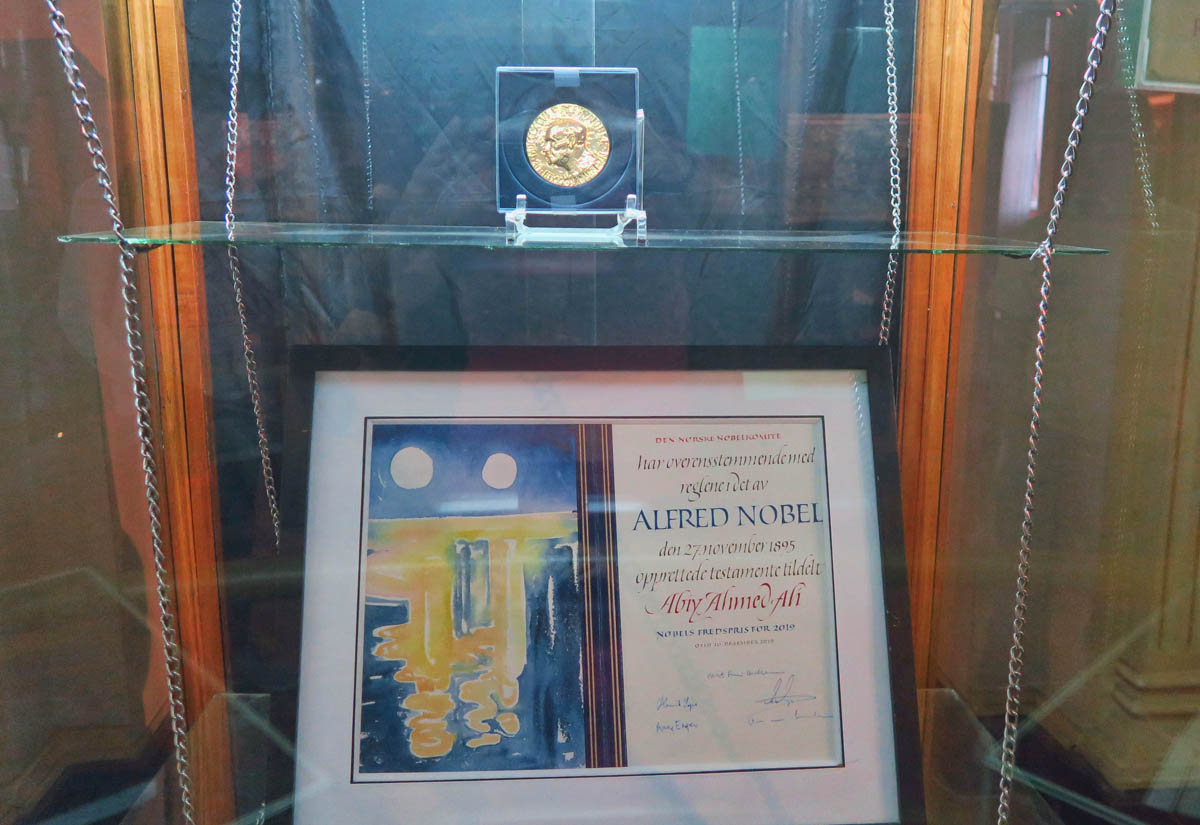
Also on display in the museum is the Nobel Peace Prize, awarded in 2019 to Ethiopian Prime Minister Abiy Ahmed Ali for his efforts to resolve the 20-year border conflict with neighboring Eritrea. You may recall that our own Dear Leader whined that the prize should have gone to him instead, falsely claiming he “saved Ethiopia from war.” A bit of trivia which gives me a particular sense of delight seeing it on display here in Ethiopia’s local museum.

The museum contains many displays of Ethiopian culture, this one being some beautiful traditional coffee pots.

In between visiting the two museums, my guide (on the left) takes me to the famous Tomoca Coffee Shop.

Established in 1953, Tomoca Coffee is Addis Ababa’s first commercial coffee shop.
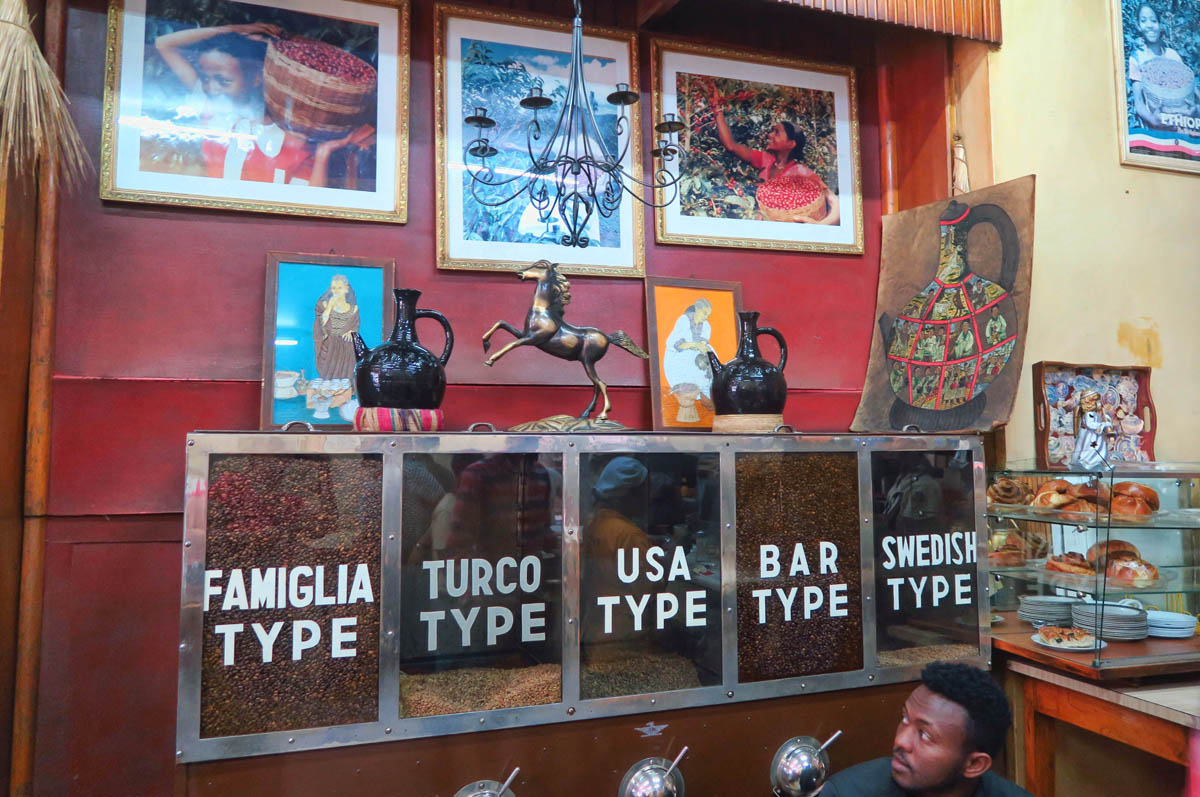
Tomoca Coffee brews Italian-style (espresso as opposed to drip-style) coffee using arabica beans. Arabica originated in the southwestern highlands of Ethiopia and is the most popular kind of coffee worldwide.

My guide orders us both a macchiato, an espresso shot with a bit of steamed milk. Strong, but oh so good!
While on the day tour, I also hoped to get a better understanding of Ethiopia’s last ruling monarch, Haile Selassie. More specifically, I wanted to understand what connection the former emperor has to the dreadlock-wearing, Bob Marley-loving Rastafarian movement, and why the Jamaican “Rastas” such as Bob Marley regard Ethiopia as their homeland. No place better to explore this than the Emperor’s former palace itself, now home of the Ethnological Museum.
As the 225th and last Emperor of the 3,000 year old Ethiopian monarchy, Selassie ruled from 1930 to 1974. His reign, along with the monarchy was ended when he was deposed by a military coup. He was believed to be a descendant of the Solomonic dynasty, formed under Menelik I, first emperor of Ethiopia. You may recall I wrote about Menelik being the illegitimate love child of King Solomon and the Queen of Sheba. Menelik’s posse is credited with bringing the Ark of the Covenant to Ethiopia.
Selassie ascended to the throne just after a Jamaican black political leader, Marcus Garvey, made a prophecy, “Look to Africa where a black king shall be crowned, he shall be the Redeemer.” This prophecy prompted the belief among followers that Selassie was the messiah. While the name Haile (meaning “Power of”) Selassie (meaning “the Trinity”) was given to the Emperor at the time of coronation, his true birth name was Tafari Makonnen. In the Ethiopian language of Amharic, “Ras” means “head, or leader,” so truncated, his name and title form “Ras Tafari,” ergo the Rastafarian movement was born.

A few of Emperor Selassie’s crowns on display in the museum.

Tour of the museum inside the palace includes Emperor Selassie’s bedroom.
On my last day in Addis, I got brave enough (more like hungry enough!) to wander out in search of the restaurant visited by Anthony Bourdain in his “Parts Unknown: Ethiopia” episode. As I have stated before, I was a huge fan of Bourdain since his first book, Kitchen Confidential, and never miss an opportunity to see what he saw, and taste what he tasted. However, unlike most establishments that exploit Bourdain’s visits with autographed photos and plaques, there is no evidence of his patronage in Addis. It took a little research to finally locate Kategna, what was the nicest, cleanest, and most modern restaurant I visited in all of Ethiopia. Pity it took me until the last day to experience it.

Kategna Restaurant in Ethiopia was the nicest place (not just restaurant) I had set foot in over the past 30 days.

It took me some research to locate it. While the restaurant name was listed in the show’s production notes, it’s a chain restaurant, so which branch was featured in Bourdain’s show?
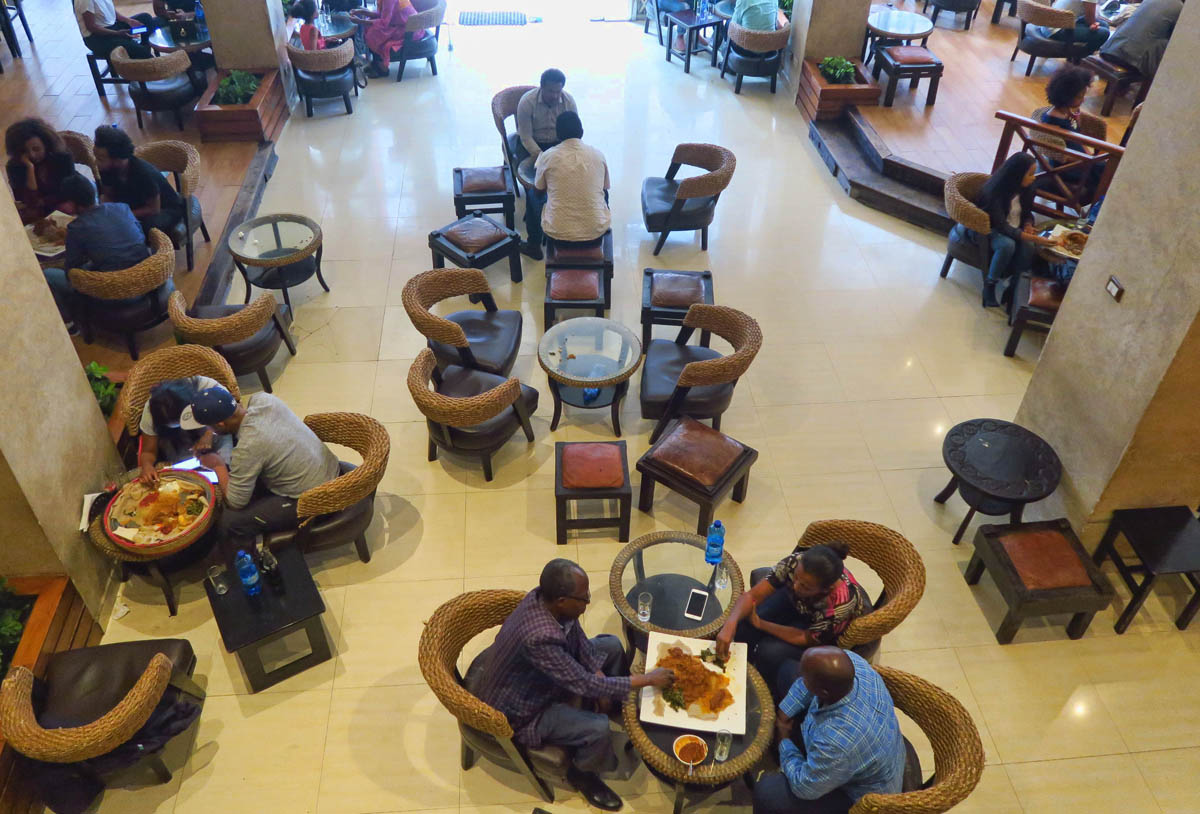
I had to narrow it down by using photos on Trip Advisor. Only the curved rattan chairs seen in the episode clued me in that this was the one.
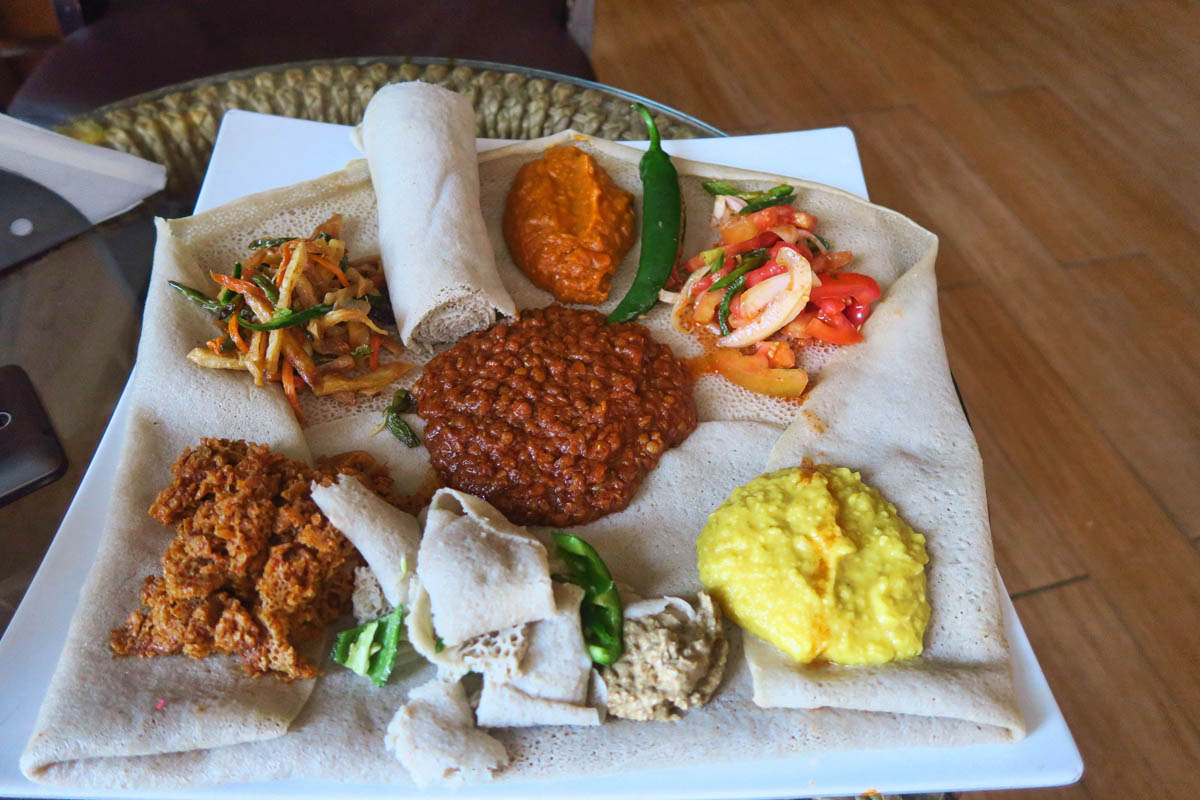
Kategna are known for their injera. It’s Friday, so I succumb to veganism by having the plant-based “Fasting Injera.” The thing rolled up like a napkin, as well as the “plate” itself beneath the sauces is the actual injera, prompting Bourdain to call it “Not just a food, but an implement.” Made from the grain teff, which contains symbiotic yeast, the only other ingredient required is water. To me, it tastes a bit like a thin sheet of foam rubber.
And so concludes my Dragoman “Deserts and Mountains of Sudan & Ethiopia” tour series. When I started out on this journey, sending New Years Eve greetings from the United departure lounge on my way to Khartoum, I knew the trip would be challenging, overlanding on rough roads, camping with no facilities, and finding creature comforts. But not just finding things like safe food to eat and clean water to drink. It would also mean carving out some personal space while living amongst a truck full of strangers for a month. But what I didn’t account for was the lack of personal space in the country overall. Every single activity drew a crowd or some in-your-face interaction, from the loud children shouting “YOU! YOU! YOU! YOU! PEN? PEN? MONEY?” while trying to hold your hand, to the creepy men who stared while whispering “faranji” (white person) as I walked by. There is no solitude, no privacy, no “me time” to be had in Ethiopia.
I set my intentions to “get comfortable being uncomfortable” on this tour. There were challenges, yes. But now in retrospect after everything we have gone through in the past two weeks and still face ahead, it was a cake walk. Ethiopia left an impression on me like no other, in observing their resourcefulness and tenacity toward sustaining life in what is one of the poorest, most populous countries on earth. Looking back, as I give more thought to my own sustenance these days, those impressions deepen even further into my psyche.
My heart goes out to Louise and James who worked so hard make sure it wasn’t just about safety and comfort, but also about having fun. Dragoman has now cancelled all tours through June, so they have joined the uncertain and untethered ranks of the unemployed. And as for those tenacious, resourceful Ethiopians, well, aside from the absence of us “faranjis,” I suspect life goes on….

You have my undying gratitude for taking the time and effort to show us all a side of the world that we are unlikely to ever experience personally. Thank you so very much! ;->
Virtual hugs,
Judie
Nice to hear from you, Judie. And I return my undying gratitude for your support! (Not to mention those virtual hugs received from the Quarantine Quarters!) Hope you and Gary are doing well…
Suzanne,
Once again you have given us a very special post. I especially found the information about the origins of the Rastafarian movement interesting. . . Ras Tafari! Is Bob Marley’s music popular in Ethiopia?
Aren’t markets fun to photograph? Your shots take me back to markets in India, China, Nepal, and many other places. Great job.
Stay well!
Thank you for sharing this amazing trip. What a ride !!! I have to agree with you about injera, it does taste like styrofoam. 🙂
The pictures and your insight really made this a trip to remember.
Hope to see you on the road when this pandemic is over.
Thanks for these posts you have given me a great insight into Ethiopia.
All I have to say is “Wow, what an adventure”. Glad you made it without getting picked!
Totally agree, what an adventure! and as I read this particular post, it struck me that if the virus makes its presence known in the capitol of Ethiopia, it will be disastrous. This little country is now on my active-list of places to keep tabs on . . . just simply because, Suzanne, you made me care.
It is going to take us several more viewings of this entire trip to be able to really “get it” so many blanks have been filled in, so many beliefs challenged that today I cannot find the words required. We loved every single stop and yesterday my grand daughters with whom I shared this issue were fascinated and grossed out when I splained how the chicken market worked and that in my youth that was the reality for much of our fowl consumption. Did not have a clue what Rastafarian meant despite having visited Jamaica in my youth. Once again thanks Suzanne for sharing, and doing that so well.
Well, another mystery solved, thank you! I always wondered about the connection between the Rastafarians and Ethiopia. That was quite a trip you had. I think I’m not tough enough to enjoy the overlanding, so I’m glad you showed it to us.
What a great trip. Thanks for sharing your wonderful photos and enlightening descriptions.
I am so glad you like to write about your travels! You put such a personal, nonjudgmental, informative, interesting perspective on each place you visit. What a trip of a lifetime.
I imagine your quarantine is over by now, stay well!
That was an incredible trip! So glad to know that it went well. You saw and learned so many new things. How absolutely scary of you to spend a week in Addis-abababa after learning all you did about the city. I can’t thank you enough for sharing this journey with all of us.
What a wonderful , informing , and entertaining way to start my Monday! Too bad Reggae Fest is canceled or this old white guy could go amaze a lot of people with his new knowledge of the beginnings of the word Rastafarian! Cant wait for whats next!
Now more than ever your travels offer escape and entertainment as well as enlightening glimpses of foreign cultures.. Your tenacity continues to inspire me. For some weird reason I like the word Addis Ababa. Where are you going: Addis Ababa she mumbled……;^)
My goodness what an adventure your 30 days have been! I don’t know why, perhaps just the way it rolls off the tongue, or photos in National Geographic, but as a child I thought Haile Selassie was wonderful. What fun you got to see his crowns, bedroom and so much more. Thank you for taking us along!
So here I go with my questions (you’d be disappointed if I didn’t) : Does Dragoman offer tours of the cities or do they just drop everyone off at each site for them to go as they please?
🙁
The coffee looks delish. Thanks for taking us along your travels!
I Love you questions, my dear Cousin! Please forgive me for overlooking this one!
If a city is part of the tour (like Axum, Lalibela, Bahia Dar, etc.) then a city tour is always included. However, in the case of Addis Ababa, it was considered a termination of the tour, so the tour notes state that one will need to allow time to explore the city on their own. But of all eleven of us, only two of us hung around for longer than a day.
xxx